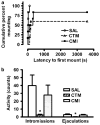Neonatal antidepressant exposure has lasting effects on behavior and serotonin circuitry
- PMID: 16012532
- PMCID: PMC3118509
- DOI: 10.1038/sj.npp.1300823
Neonatal antidepressant exposure has lasting effects on behavior and serotonin circuitry
Abstract
A significant fraction of infants born to mothers taking selective serotonin reuptake inhibitors (SSRIs) during late pregnancy display clear signs of antidepressant withdrawal indicating that these drugs can penetrate fetal brain in utero at biologically significant levels. Previous studies in rodents have demonstrated that early exposure to some antidepressants can result in persistent abnormalities in adult behavior and indices of monoaminergic activity. Here, we show that chronic neonatal (postnatal days 8-21) exposure to citalopram (5 mg/kg, twice daily, s.c.), a potent and highly selective SSRI, results in profound reductions in both the rate-limiting serotonin synthetic enzyme (tryptophan hydroxylase) in dorsal raphe and in serotonin transporter expression in cortex that persist into adulthood. Furthermore, neonatal exposure to citalopram produces selective changes in behavior in adult rats including increased locomotor activity and decreased sexual behavior similar to that previously reported for antidepressants that are nonselective monoamine transport inhibitors. These data indicate that the previously reported neurobehavioral effects of antidepressants are a consequence of their effects on the serotonin transporter. Moreover, these data argue that exposure to SSRIs at an early age can disrupt the normal maturation of the serotonin system and alter serotonin-dependent neuronal processes. It is not known whether this effect of SSRIs is paralleled in humans; however, these data suggest that in utero, exposure to SSRIs may have unforeseen long-term neurobehavioral consequences.
Neuropsychopharmacology (2006) 31, 47-57. doi:10.1038/sj.npp.1300823; published online 13 July 2005.
Figures








References
-
- Ansorge MS, Zhou M, Lira A, Hen R, Gingrich JA. Early-life blockade of the 5-HT transporter alters emotional behavior in adult mice. Science. 2004;306:879–881. - PubMed
-
- Azmitia EC. Modern views on an ancient chemical: serotonin effects on cell proliferation, maturation, and apoptosis. Brain Res Bull. 2001;56:413–424. - PubMed
-
- Bjerkenstedt L, Flyckt L, Overo KF, Lingjaerde O. Relationship between clinical effects, serum drug concentration and serotonin uptake inhibition in depressed patients treated with citalopram. A double-blind comparison of three dose levels. Eur J Clin Pharmacol. 1985;28:553–557. - PubMed
-
- Casper RC, Fleisher BE, Lee-Ancajas JC, Gilles A, Gaylor E, DeBattista A, et al. Follow-up of children of depressed mothers exposed or not exposed to antidepressant drugs during pregnancy. J Pediatr. 2003;142:402–408. - PubMed
-
- Cohen LS, Nonacs R, Viguera AC, Reminick A. Diagnosis and treatment of depression during pregnancy. CNS Spectr. 2004;9:209–216. - PubMed
MeSH terms
Substances
Grants and funding
LinkOut - more resources
Full Text Sources
Medical

